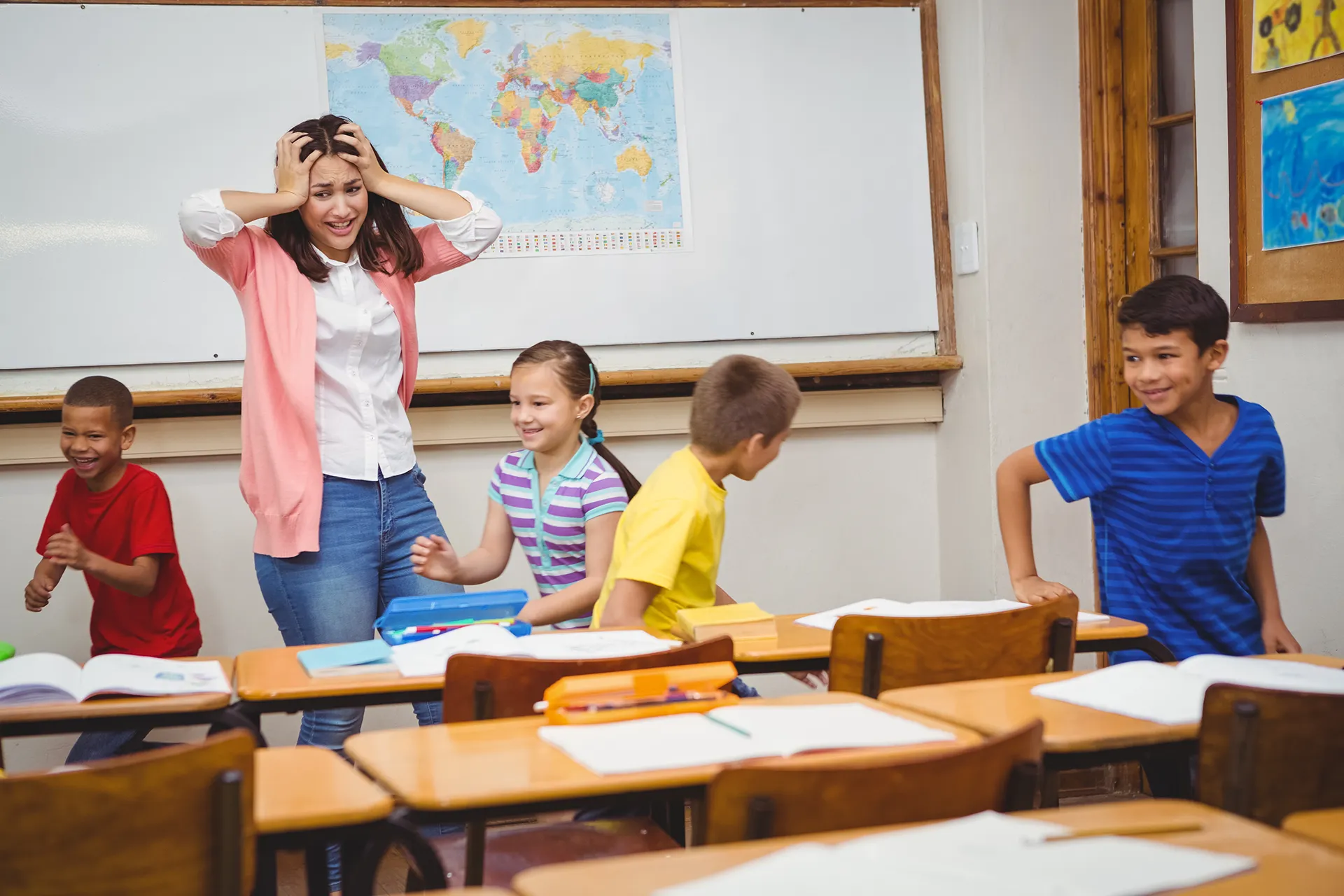
Policymakers, administrators, and teachers should work together to develop comprehensive strategies and initiatives that promote positive behaviour.
While there has been abundant media and social media discussion about the topic of late, it would be inaccurate to make a blanket statement that schools have lost control of student behaviour in classrooms and that there is some sort of crisis in our schools.
Schools and teachers play a crucial role in maintaining and creating a conducive learning environment. They typically have policies and behaviour management measures in place to address disruptive behaviour and ensure the smooth functioning of classrooms. However, it’s important to recognise that various factors can influence classrooms, such as changes in societal dynamics, technological advancements, and individual student circumstances, which can present new challenges. This is what we are seeing.
In recent months, and it isn’t new, concerns have been raised about issues like bullying, student disengagement, mental health, technology’s impact on classroom dynamics, and the rampant use of social media in the playground.
It’s worth noting that schools and school systems continuously adapt and evolve to address these challenges. They often implement strategies for classroom management, student support services, teacher training, and parental involvement to create a positive and structured learning environment. While individual incidents may occur, it would be inaccurate to generalise and claim that schools have universally lost control of classrooms.
The issue of control in the classroom is a complex and multifaceted one. All teachers have the same ideals: establish a supportive environment by focussing on creating a classroom culture that encourages mutual respect, open communication, and collaboration. Teachers want all students to feel safe and supported, which fosters a positive learning atmosphere. Implementing effective classroom management strategies can help teachers maintain a healthy learning environment while allowing students to actively engage in learning. All teachers know the importance of fostering an environment that promotes engagement, respect, and collaboration. When teachers and students work together as partners in the learning process, the classroom becomes a space where everyone can thrive.
It would seem, though, from the extensive coverage given to the well-being of teachers in the media and social media, that all is not well in classrooms across the country. Teachers are more stressed than ever trying to sustain healthy classrooms by enforcing reasonable expectations and standards of behaviour and learning. This is a complex issue, but why are we at this place? Classroom learning environments are not what teachers had hoped they would be.
Do Schools Need to be Stricter on Students?
The question of whether schools need to be stricter on students is subjective and depends on various factors. More stringent rules and enforcement can be seen as a way to maintain order, discipline, and a focused learning environment. Proponents argue that stricter policies can promote a sense of responsibility, respect for authority, and adherence to rules. They believe that a structured environment helps students develop self-control, accountability, and good habits that are essential for success in academics and later in life.
However, it’s important to consider the potential drawbacks of strictness. Overly strict policies may lead to a more oppressive and rigid environment, stifling creativity, individuality, and critical thinking. Some argue that rigorous discipline can have adverse psychological effects on students, leading to stress, anxiety, or a fear of making mistakes.
An alternative approach focuses on fostering a positive and supportive school culture, emphasising the importance of empathy, communication, and mutual respect. This approach aims to create a safe and inclusive learning environment where students are motivated intrinsically to behave responsibly and meet academic expectations.
Ultimately, finding the right balance between discipline and liberality in schools is crucial. When designing effective behaviour management strategies, it’s important to consider individual students’ needs, developmental stages, and cultural contexts. Collaborative efforts involving educators, parents, and students can help establish policies that promote learning, character development, and overall well-being.
It’s important to recognise that discipline is a complex issue influenced by various factors, including societal changes, parenting styles, student behaviour, and school culture. It requires a multi-faceted approach that involves collaboration between all stakeholders. Policymakers, administrators, and teachers should work together to develop comprehensive strategies and initiatives that promote positive behaviour, create a safe and respectful learning environment, and provide appropriate support for teachers to address discipline challenges.
Policymakers may sometimes not provide adequate support or resources to address school discipline-related issues. This can make it challenging for teachers to enforce discipline and maintain order in the classroom effectively. Teachers may feel let down if they perceive a need for more support or clear guidelines from policymakers.
Can Policy Makers, Administrators and Our Most Senior Leaders and Managers in Our Schools do More to Support Teachers in Classrooms?
Yes, they can.
Policymakers can prioritise funding for education, ensuring that schools have the necessary resources to support teachers in managing classroom behaviour effectively. This includes funding professional development programs, training on behaviour management strategies, and access to instructional materials and technology. This can include evidence-based strategies for creating positive learning environments, dealing with challenging behaviours, and fostering social-emotional skills in students.
Policymakers can create policies that promote positive behaviour and provide guidelines for addressing challenging behaviours. These policies should be realistic and practical, considering students’ diverse needs and the specific challenges teachers face.
Policymakers should also involve teachers and education experts in the development of these policies to ensure their effectiveness.
Policymakers can encourage collaboration between schools, teachers, parents, and community stakeholders to address classroom behaviour issues. This can involve creating platforms for sharing best practices, establishing mentorship programs, and fostering partnerships between schools and mental health professionals or behaviour specialists.
Policymakers can work to reduce the administrative burden on teachers, allowing them to focus more on teaching and student support. Streamlining paperwork, reducing excessive standardised testing, and providing sufficient planning and preparation time can alleviate the workload and enable teachers to devote more attention to addressing behaviour concerns.
Policymakers can publicly acknowledge and appreciate the valuable work of teachers in managing classroom behaviour. Recognising their efforts and providing emotional support can boost teacher morale and motivation.
Teachers, of course, and naturally, have a crucial role to play. I am confident that teachers are using appropriate and well-tested strategies to ensure a classroom environment that is conducive classroom. So, let these strategies affirm what teachers know and do.
- Establish Clear Expectations: Clearly communicate your expectations regarding behaviour, participation, and academic performance from the beginning. Create a set of classroom rules or guidelines that are easy to understand and enforce. And be sure to maintain high standards, consistency, and constancy in applying your classroom rules.
- Build Positive Relationships: Foster a positive and respectful relationship with your students. Show genuine interest in their well-being and academic progress. Establishing a supportive environment makes students more likely to adhere to classroom rules and guidelines. Be sure to include families in building positive and respectful relationships.
- Consistent and Fair Consequence: Implement a consistent and fair consequences system for inappropriate behaviour. Make sure the consequences for unacceptable behaviour are clear and consistently applied. Focus on teaching students about the consequences of their actions rather than just punitive measures.
- Classroom Routines and Procedures: Establish clear routines and procedures for various activities, such as entering and exiting the classroom, transitioning between lesson components, or distributing and collecting materials. Routines help create a structured environment and minimise disruptions. Most learners crave routines.
- Engaging Instruction: Plan and deliver quality lessons that engage students’ appetite for learning. Incorporate various teaching strategies and appropriate challenges, including visual aids, hands-on activities, group work, and technology, to keep students actively involved and reduce the likelihood of misbehaviour due to boredom.
- Differentiation and Individualisation: Recognise and accommodate students’ diverse learning needs by differentiating instruction. Adjust your pedagogy and materials to meet individual students’ abilities, interests, and learning styles. When students feel their needs are being met, they are more likely to remain engaged and well-behaved.
- Effective Classroom Management Techniques: Utilise specific techniques like proximity control (moving closer to students who need redirection), non-verbal cues (eye contact, hand signals), and positive reinforcement (verbal praise, rewards) to address individual or group behaviour concerns promptly and effectively.
- Time Management: Plan and structure your lessons effectively, allowing for a balance between instruction, activities, and transitions. Clear time expectations and efficient use of instructional time can help minimise disruptions and keep students engaged.
- Collaborate with Colleagues and Support Staff: Communicate with other teachers, leaders, and support staff to share strategies, seek advice, and collaborate on managing challenging behaviours. Collaboration can provide additional perspectives and resources to address classroom management concerns effectively.
- Reflection and Adaptation: Regularly reflect on your classroom management strategies and their effectiveness. Modify and adapt your approach as needed based on the specific dynamics and needs of your students. Continual improvement is essential for maintaining a well-managed classroom.
Remember, no single strategy works for every classroom or every student. Flexibility and willingness to adjust your approach based on your student’s unique needs and circumstances is crucial.
It’s worth noting that the approach to discipline in schools can vary across different educational systems, jurisdictions, and cultures. What may work in one context may not necessarily be applicable in another. Therefore, it’s important for policymakers to consider local needs and engage in dialogue with educators to develop effective and responsive policies to the specific challenges they face.


